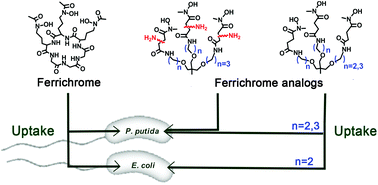Biomimetic ferrichrome: structural motifs for switching between narrow- and broad-spectrum activities in P. putida and E. coli†
Abstract
A series of novel ferrichrome (FC) analogs was designed based on the X-ray structure of FC in the FhuA transporter of Escherichia coli. Two strategies were employed: the first strategy optimized the overall size and relative orientation of H-bonding interactions. The second strategy increased H-bonding interactions by introducing external H-donors onto analogs’ backbone. Tris-amino templates were coupled to succinic or aspartic acid, and the second carboxyl was used for hydroxamate construction. Succinic acid provided analogs without substituents, whereas aspartic acid generated analogs with external amines (i.e. H-donors). All analogs had similar physicochemical properties, yet the biological activity in Pseudomonas putida and E. coli showed great variation. While some analogs targeted specifically P. putida, others were active in both strains thus exhibiting broad-spectrum activity (as in native FC). Narrow-spectrum or species-specificity might find application in microbial diagnostic kits, while broad-spectrum recognition may have advantages in therapeutics as siderophore–drug conjugates. The differences in the structure and range of microbial recognition helped us in formulating guidelines for minimal essential parameters required for inducing broad-spectrum activity.


 Please wait while we load your content...
Please wait while we load your content...